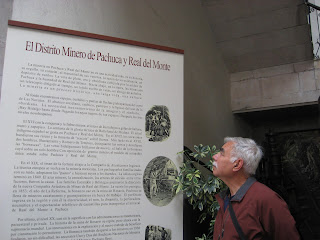 |
| Raising the Bell mechanism weight |
 |
| 100 year old British made bell control mechanism |
 |
| Pachuca's bell tower celebrating indeendence of 1910 |
We arrived at the Pachuca bus terminal at 10.15 AM and within 15 minutes we were aboard a green-striped Colectivo minibus headed for the center of Pachuca 20 minutes away. I found the business model of this enterprise interesting. There was a queue of about 5 of these mini buses. Passengers were packed like sardines in the head bus, then it was sent on its way and the net bus would be filled up. The advantage to us passengers was low cost. The total charge for Brenda and myself was 11 pesos (about 90 cents).
We got off the bus at centro, the center of the city, next to the Plaza de la Constitucion and managed to find our way to the Plaza de la Independencia (the zocalo) between Allende and Matamoros. On Allende we found the Gran Hotel Independencia which is mentioned in our guide. The price was OK at 440 pesos so we checked in and were in our room at 11.30 AM, giving us plenty of time for looking around the city.
 |
| Hotel, Brenda at right in front of room |
 |
| Statue of Christ overlooking city |
The climb was well worth the effort. The center of attention was a wonderful mechanism built in London and installed in 1910 when the tower was commissioned to commemorate the achievement of Mexican independence. The mechanism was in mint condition and appeared to me that it would easily run for another 200 years. Its purpose is to keep time and trigger the ringing of the bells at the quarter hour and full hour. On the quarter hour the equipment came to life, gears spun around, lines were pulled, and the bells rang.
 |
| One of Pachuca's quieter streets. Note mountain. |
The entire affair is powered by two large weights and one smaller one, much as in a grandfather clock. Every three days a crank is used to raise the weights to their full height. Today was the third day and the guide did his cranking demonstration then got me involved. At first the cranking was risibly easy but with time it got more and more difficult. But this old dog of 67 was not going to show weakness to 6 young senoritas and mercifully the weight got to the top before I got to cardiac arrest. The girls then had a go and I was amazed at how physically weak they were. Maybe that was a good sign of easy modern living.
 |
| At the Pachuca mining museum |
I had a special interst, of course. My boat was built by a mining engineer in Western Australia. I've been informed that a "pachuca" is some sort of vessel for treating gold ore in Western Australia. Brenda and I suspect that that name came from a similar devise used here in Pachuca in its gold treatment process.
Unfortunately although Brenda and I scrutinized the Spanish language exhibits very closely we could not find any explicit reference to any piece of equipment called a "pachuca", but then why would there be, if it was part of the local mining scene? I did see a tantalizing reference to an invention by a local person of a new gold processing method, but could not find a definite link.
Brenda's Mealtime Story 4: A food specialty here is the paste. Pastes are very popular and there are many outlets. They are the local version of the Cornish pastie. Back around 1849, a British company bought into the mining industry here. They hired and imported some Cornish miners. These miners brought not only their skills in modern, more mechanized mining but the pastie which is ideal for the underground meal - pastry encasing a mix of beef mince and vegetables such as potato, carrot, turnip and onion. Pachuca pastes come with fillings such as well-spiced tuna and potatoes, chorizo and beans, and several more savoury fillings as well as a popular rice pudding, and a pineapple custard version. The pastry is either flakey pastry or rich flakey pastry. I have always liked pasties so it is a form of heaven to be in a city where they are so readily available.
Incidentally, the Cornish miners are also credited with introducing soccer to Mexico - now a national obsession.


2 comments:
Bob - you were right. Quality (of the clock mechanism) meant something back then in 1910. Great Post...
Unreal...a city named like your ship!
Post a Comment